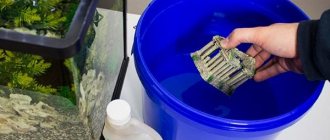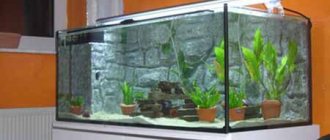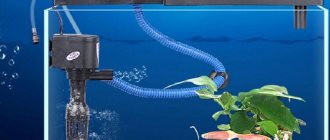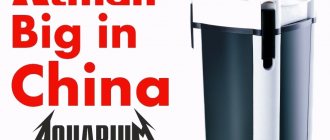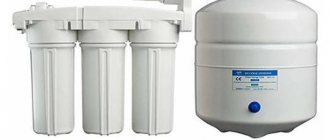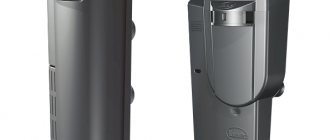5
(8)
Poor quality water can ruin even human health. For more vulnerable creatures, it poses an even greater danger. This is especially true for representatives of underwater flora and fauna, which are extremely sensitive to the aquatic environment and the life of these animals directly depends on its parameters and quality.
Unfortunately, the water coming from the water supply is very bad. You never know what impurities may be stored in it, in addition to the already familiar heavy metals and chlorine. Therefore, adding unsettled water to the aquarium is a real roulette.
However, it's not just the composition of the liquid. Its parameters are also important. For example, an aquarist decided to turn his aquarium into a pseudo-sea in which cichlids will swim. Under natural conditions, they live in hard water, but soft water can flow from the tap. Some animals need salt water, but the tap water needs alkaline water, etc. That is, the parameters of water in a particular region are not always similar to that needed by certain flora and fauna.
Some fish can get used to different conditions, but there are also animals and plants that die in unsuitable water. To prevent such an outcome, you need to control the water parameters in the aquarium yourself. This can be achieved in different ways, and one of the most effective options is to install osmosis for the aquarium.
What is osmosis?
Reverse osmosis in an aquarium is a process during which liquid passes through a special membrane and is cleaned of salts, dirt and other elements. In other words, after the reverse osmosis filter operates, 90% of the minerals are removed from the liquid.
There are different reverse osmosis filters available in stores, which differ from each other in the following ways:
- Degree of liquid purification.
- Productivity.
- A type of membrane.
The most popular is a filter with a membrane in the form of a composite film, which is characterized by an effective degree of water purification. In addition, a mechanical and carbon filter are additionally introduced into the reverse osmosis filter.
Interesting fact: scientists first learned about the existence of this type of cleaning thanks to seagulls. Having noticed that these birds drink salt water harmlessly, scientists found out that there is a membrane in the beak of seagulls that converts salty liquid into fresh.
Maintenance and Testing
Maintenance is carried out immediately after installation. Follow-up maintenance is performed after each use. During the maintenance process, the mechanical filter, membrane and other components are replaced.
1–2 months after installation, the quality of the resulting liquid is assessed. For these purposes, testing kits are used to determine alkalinity, acidity and hardness. As soon as these indicators increase, cartridges and membranes are replaced.
Why is osmosis needed?
Maintaining an artificial pond with fish is a responsible undertaking, because silent pets are unable to take care of themselves. Every aquarist knows that certain types of fish require individual water parameters, and it is difficult to bring tap liquid into a state suitable for fish to live in. Therefore, experienced owners use osmosis installations for the aquarium, which help bring water parameters back to normal.
The systems are used for both freshwater and marine aquariums. Creatures that live in salty bodies of water are demanding in terms of the content of phosphates, nitrates and sulfates. Therefore, for capricious pets, a liquid prepared artificially is used - water is prepared using a filter, after which the necessary components are added.
In freshwater tanks, installing such a system is necessary for keeping shellfish or shrimp that do not tolerate the accumulation of metals in liquid. This type of filter is also used for breeding Apistogramma cichlids - this phenotype requires clean and soft water for reproduction.
Replacing reverse osmosis filters
Sooner or later, system components need to be changed. The frequency of replacement depends on the intensity of use and the condition of the water. As a general rule, an inside-out sediment prefilter should be renewed every 4 months. This is preceded by a change in the color of the water. Some reverse osmosis systems have a transparent housing that is resistant to ultraviolet radiation, which allows you to evaluate the condition of the filter by its appearance. The carbon prefilter, whose condition depends on the sediment prefilter, should be replaced every 6 months. When filters are depleted, the efficiency of the system and the volume of water processed decreases. The membrane replacement schedule is variable. The average lifespan of reverse osmosis for drinking water is three years. In the process of water treatment for aquariums, it is reduced due to more active use of the system. The service life of the membrane can be increased by washing it. If performance has seriously decreased and replacing the prefilters does not help, the membrane should be updated. The harder the water being purified, the more often it needs to be changed. The condition of the membrane can be checked using a water condition assessment. As the membrane wears, the total dissolved solids will increase.
It is normal for the water obtained through reverse osmosis to have slightly different parameters, since the pH of tap water varies in different areas.
Owners of reverse osmosis systems have the opportunity to improve their performance by replacing the membrane and flow restrictor fitting. The fact is that 150/100/50 GPD reverse osmosis membranes have the same diameter, but they have different densities. The flow restrictor ensures adequate flow according to the membrane density. The 100 GPD model is not much more expensive than the 50 GPD membrane.
Benefits of Osmosis
The popularity of the device is due to the following factors:
- Cleanliness – environmental materials are used in the manufacture of filters of this kind, so you don’t have to worry about the health of the flora and fauna in the aquarium. In addition, it is much more pleasant to keep fish and plants in a clean tank.
- Quality of cleaning - the filter cleans quickly and efficiently, removing organic compounds, life-threatening impurities, and chemical components.
- Compactness – the device is small in size and convenient to use. Filtering is carried out by owners in several stages.
Purchase of a treatment plant
Before you start purchasing a cleaning device, it is worth planning how many containers you will use at the same time. Otherwise, the device will be quite expensive and unaffordable. Of course, it's good that you are a kind-hearted host. But it is worth knowing the efficiency and profitability of a useful mechanism.
So, it’s worth summing up some conclusions. The first thing is to study information about the types of fish that need cleaning of the container in which they will live for a long time.
The second is the cleaning process itself. After cleaning the container, you should absolutely not use clean water, because most fish are simply not accustomed to it.
Third, it is worth adding peat moss, which helps improve the microflora of the water.
And remember, your fish need a good owner. Make your fish happy and clean the container in which they swim.
DIY osmosis for an aquarium
The only drawback to osmosis in aquarium farming is the high cost of the filter, but the solution to this problem is to assemble a reverse osmosis device for an aquarium with your own hands. The components can be purchased in stores, and assembly at home will take 2-4 hours. To assemble osmosis with your own hands, you will need the following items:
- Mechanical and carbon filter.
- Membrane housing.
- Membrane.
- A container for liquid passing through the device.
- Couplings, connecting tubes.
- Tap.
It’s easy to build the device yourself: the membrane is inserted into the housing and connected to the filters using a tube so that water passes first through the filter cartridges, and lastly through the membrane. One of the tubes is connected to the water supply using a coupling and a ball valve. The second two tubes are located at the end of the device: one tube must be secured in a container intended for purified water. The second tube is connected to the sewer to drain the liquid: a hole is drilled in the siphon, a gasket is glued and half rings are installed, then a tube is inserted into the hole and the bolts are tightened.
How is osmosis water better than tap water?
There are no secrets here. Modern water supply, probably in every settlement in the post-Soviet space, is not of the best quality. Many pipes have not been replaced for decades, and the cleaning system is so outdated that it cannot cope with current tasks.
In many countries and regions, chlorine is still used, which, although it kills “infection,” is itself a rather aggressive and dangerous substance. The disadvantages of tap water are as follows:
- It has an unknown composition. To identify it, you need to order a special examination, which, of course, is not free;
- It passes through old and dirty pipes, covered with rust and unknown contaminants;
- Such water is initially poorly purified, and most often is completely technical. That is, it cannot be drunk or used for cooking. Pouring into an aquarium - even more so;
- In some regions, water does not have the best parameters. It may be relatively clean, but excessively hard, sour, etc.
Reverse osmosis for an aquarium eliminates all these disadvantages. Firstly, the system is used not only for a home pond. This is a common household appliance that is installed near the sink in the kitchen and water from it can be used by all family members for their own purposes. Secondly, this system makes it possible to fully control the composition of water, its quality and parameters. The aquarist will know what it contains and what its characteristics are. He will be able to get optimal water for his aquarium, for the set of plants and fish that are kept in his aquarium.
Features of use
Having assembled a water purification system yourself, before using the device you need to consider several nuances:
- When preparing the aquatic environment for a tank, you should understand that store-bought phenotypes have spent their entire lives in artificially created conditions, so the parameters of their natural habitat may be alien to them. In order to properly prepare the liquid for filling the reservoir, it is necessary to take into account the individual needs of the fish and the conditions in which the pets were previously kept.
- When using osmosis for the first time, you should not suddenly change water parameters, since such changes in the composition of the liquid will cause stress and deterioration in the health of the fish. The composition of the water in the aquarium is changed little by little.
- Osmosis water, although completely purified from harmful substances, is not suitable for keeping fish in its pure form. The device washes out not only dirt and impurities from the liquid, but also valuable minerals and elements, so a little tap liquid is added to the reservoir.
A reverse osmosis filter for water purification will help to completely neutralize dangerous impurities and substances in tap liquid, making it suitable for keeping fish. To avoid negative consequences when using the device, you must listen to the advice of experts and adhere to the rules of use.
Flushing
When the RO system is used only to treat drinking water, the membrane wears out slowly. For example, a 50 GPD membrane will easily maintain a constant water level in a 12 - 20 liter container. However, when larger scale water treatment is carried out, the membrane wears out much faster and must be constantly cleaned. This procedure involves opening the valve for 3 to 5 minutes to remove accumulated mineral residues from the membrane. Remember that water enters it under pressure, while clean water passes through, and solid particles (minerals) are eliminated by the waste water outlet. However, not all particles are removed, accumulating on the membrane, which reduces its effectiveness. Washing removes these particles. Regular washing will extend the life of the membrane . Some filters provide automatic washing.
How to choose the right aquarium filter
Each filter has its pros and cons. To purchase the right unit for your aquarium, there are some features you should pay attention to.
Important selection criteria:
1. Volume of the aquarium. Each filter is focused on purifying a certain volume of water. Buy a design of suitable performance with a reserve of 10 liters.
2. Device power. This parameter determines how long it will take to purify the water. The most powerful filters pump 400-600 liters of liquid in 1 hour. This type of equipment is optimal for installation in large aquariums.
3. Type of filtration – mechanical, chemical, biological treatment.
4. Type of filter filler.
5. Economical power consumption.
6. Adjustment of the pressure of the outgoing flow. Some fish love a calm atmosphere, and if purified water is supplied back under high pressure, they may die. To avoid such consequences, it is recommended to choose a filter with a fan mode of water injection, which ensures uniform distribution without pressure.
7. Noise level during operation.
Types of filtration in an aquarium
Based on their filtering capabilities, devices are divided into several types.
Types of filters:
1. Mechanical - water is filtered through a special sponge that retains fish waste products.
2. Biological phytofilter - water purification is carried out by beneficial bacteria that process waste products of the inhabitants of the aquarium.
3. Chemical filters with special fillers that cause a natural chemical reaction, due to which water is purified from various contaminants. The filler can be zeolite, activated carbon and other materials.
